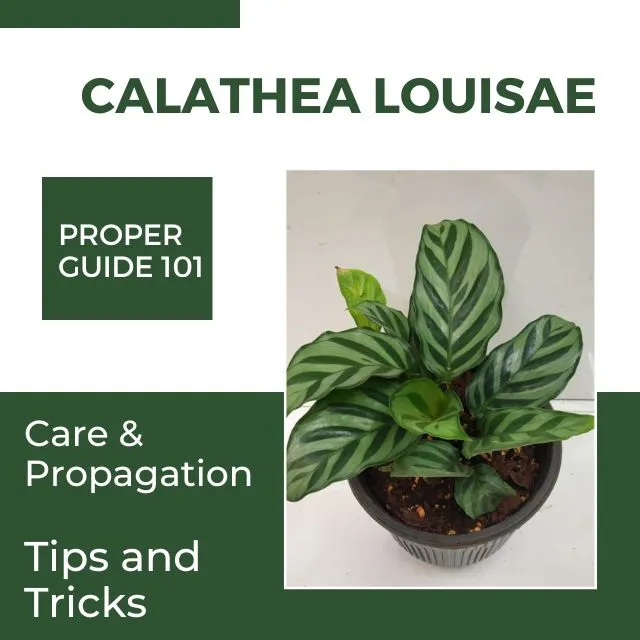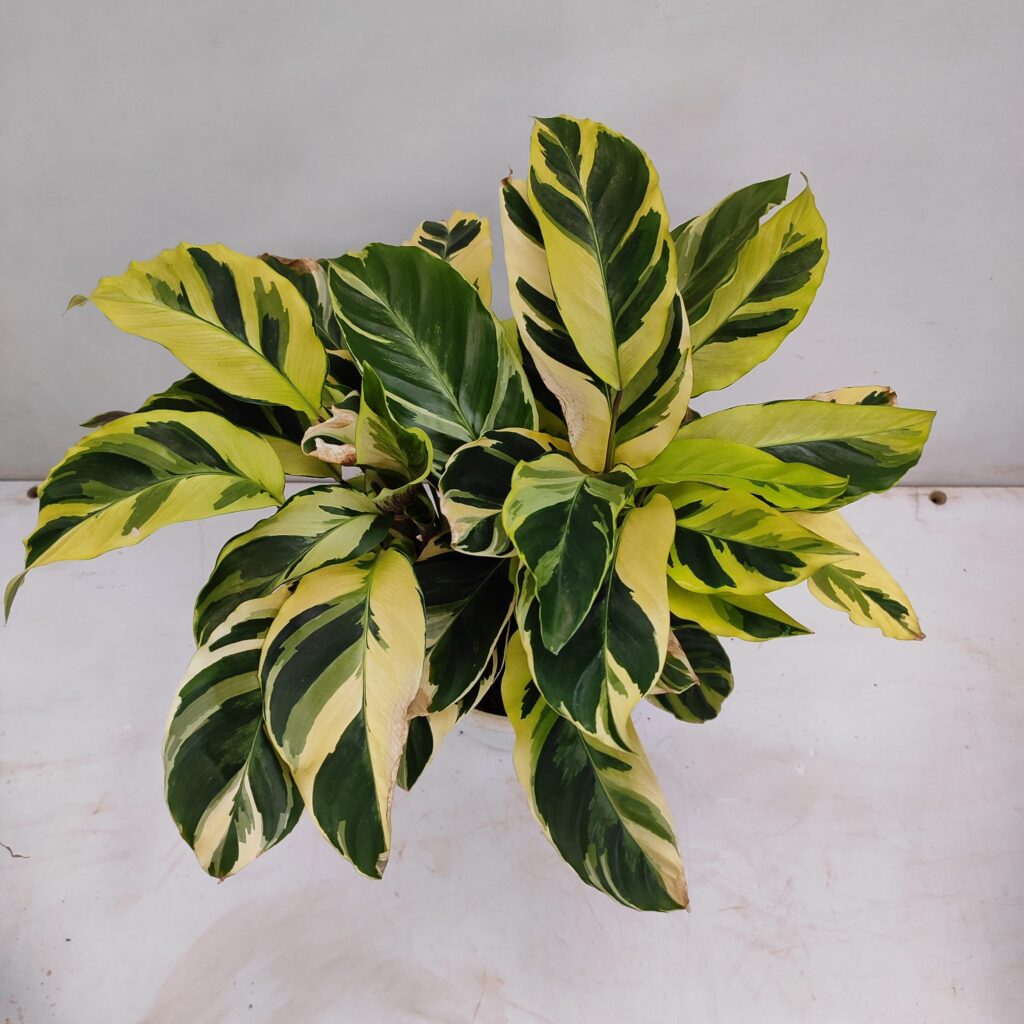Calathea louisae, also known as the rattlesnake plant or network plant, is a species of tropical evergreen plant in the Marantaceae family. It is native to South America, particularly Brazil, and is popular as a houseplant due to its attractive foliage and low-maintenance requirements.
The leaves of the Calathea louisae plant are characterized by their striking green and silver markings resemble the skin of a rattlesnake, hence the common name. The plant can grow up to 2 feet tall and 1 foot wide, making it a good choice for smaller indoor spaces.
In addition to its ornamental value, Calathea louisae has a unique ability to move its leaves in response to changes in light and temperature, making it an attractive plant to observe. Overall, it is an excellent addition to any plant collection and a favorite among plant enthusiasts.

Characteristics of Calathea Louisae
Calathea louisae is a beautiful and unique houseplant with the following characteristics:
1. Foliage: The leaves of Calathea louisae are its main attraction. They are long, narrow, and pointed, with a distinct pattern of green and silver markings resembling a rattlesnake’s skin. The underside of the leaves is usually purple or burgundy, which adds to the plant’s visual appeal.
2. Size: Calathea louisae is a compact plant that typically grows to a height of about 2 feet and a width of about 1 foot. This makes it ideal for smaller indoor spaces, such as apartments, offices, or bedrooms.
3. Movement: Calathea louisae is a unique plant that has the ability to move its leaves in response to changes in light and temperature. During the day, the leaves will open up to absorb sunlight; at night, they will close up to conserve energy.
4. Low maintenance: Calathea louisae is a relatively low-maintenance plant that can thrive in various indoor environments. It prefers moderate to bright indirect light, and its soil should be kept consistently moist but not waterlogged.
5. Air-purifying: Like many other houseplants, Calathea louisae has been shown to have air-purifying properties, which means it can help improve the air quality in your home or office by removing toxins and pollutants from the air.
Complete Calathea Louisae Care Guide
A complete care guide for Calathea louisae is provided:
Light Requirements
Calathea louisae prefers bright indirect light. Direct sunlight can burn the leaves, so it’s best to place the plant near a window that receives filtered light or in a spot with bright, indirect light.
Water Requirements
Calathea louisae likes to be kept consistently moist but not waterlogged. Water the plant when the top inch of soil feels dry to the touch, and be sure to use water that is at room temperature. Avoid letting the soil dry out completely, which can cause the leaves to wilt.
Humidity Requirements
Calathea louisae thrives in humid environments. You can increase humidity by placing a tray of water near the plant, using a humidifier, or misting the leaves with water once or twice a week.
Temperature Requirements
Calathea louisae prefers temperatures between 60°F and 75°F (15°C to 24°C). Avoid exposing the plant to temperatures below 55°F (12°C) or drafts, as this can damage the leaves.
Soil Requirements
Calathea louisae prefers well-draining soil that is rich in organic matter. Use a potting mix that contains peat moss, perlite, and vermiculite.
Fertilizer Requirements
Feed Calathea louisae with a balanced liquid fertilizer once a month during the growing season (spring and summer). Reduce fertilizer during the fall and winter months.
Pruning Requirements
Trim any brown or yellow leaves as soon as you notice them. This will prevent the plant from wasting energy on dead or dying leaves and promote healthy growth.

Step by Step Calathea Louisae for Successful Propagation
Calathea louisae can be propagated through division. Here are the steps to propagate Calathea louisae:
1. Choose a Healthy Plant:
Select a healthy and mature Calathea louisae plant for propagation. Ensure that the plant has several stems or stalks, which will make division easier.
2. Prepare the New Pot:
Fill a new pot with fresh potting soil that is rich in organic matter. Make sure the pot has drainage holes to avoid waterlogging.
3. Remove the plant from its pot:
Gently remove the plant from its pot, being careful not to damage the roots. You can do this by carefully turning the pot upside down while holding the base of the plant with your hand.
4. Separate the plant:
Once the plant is out of its pot, gently separate the stems or stalks. You can do this by carefully pulling the roots apart with your hands or using a clean and sharp knife to divide the root system.
5. Repot the new plants:
Once the plant has been separated into individual sections, repot each section into its own pot. Be sure to cover the roots with soil and water thoroughly.
6. Care for the new plants:
After repotting, place the new plants in a warm and bright location but away from direct sunlight.
Keep the soil moist but not waterlogged, and maintain high humidity by misting the leaves regularly or placing a tray of water near the plant.
7. Monitor growth:
Keep an eye on the new plants and watch for signs of growth. Once the new plants have become established, you can resume normal care, including regular watering and fertilization.
Common Problems & Solutions
Here are some common problems that you might encounter when caring for Calathea louisae:
1. Brown tips on leaves:
This can be caused by over-fertilization, overwatering, or low humidity.
Reduce fertilization, ensure the soil is moist but not waterlogged, and increase humidity by misting the leaves or using a humidifier.
2. Yellowing leaves:
This can be caused by overwatering, underwatering, or exposure to direct sunlight.
Check the soil moisture and adjust watering accordingly, move the plant to a spot with bright, indirect light, and avoid direct sunlight.
3. Curling leaves:
This can be caused by low humidity, cold temperatures, or exposure to direct sunlight.
Increase humidity by misting the leaves or using a humidifier, maintaining a warm and consistent temperature, and moving the plant to a spot with bright, indirect light.
4. Drooping leaves:
This can be caused by underwatering or overwatering.
Check the soil moisture and adjust the watering accordingly. If the soil is waterlogged, allow it to dry before watering again.
5. Pest infestations:
Calathea louisae can be prone to spider mites, mealybugs, and scale insects.
Check the leaves regularly for signs of infestation, such as tiny webs, cottony spots, or small bumps. Treat promptly with insecticidal soap or neem oil.
6. Root rot:
This can be caused by overwatering or poorly draining soil. Ensure that the pot has drainage holes and that the soil is well-draining.
Water the plant only when the top inch of soil is dry to the touch. If root rot has already set in, repot the plant into fresh soil and remove any damaged roots.
Conclusion
Calathea louisae is a beautiful and unique houseplant that can add a touch of tropical elegance to any indoor space. With its vibrant green leaves and striking patterns, this plant will surely stand out in any collection.
To care for Calathea louisae, provide bright indirect light, consistently moist but well-draining soil, and high humidity.
Keep an eye out for common problems like overwatering, low humidity, and pest infestations, and address them promptly to keep your plant healthy and thriving.
With proper care, Calathea louisae can be a stunning and rewarding addition to your indoor garden.
Also Check: Calathea Crocata: Care Guide and Propagation Tips
Frequently Asked Questions about Calathea Louisae
Is Calathea louisae toxic to pets?
Calathea louisae is non-toxic to pets, according to the ASPCA. However, it’s always a good idea to monitor your pets around plants and consult with a veterinarian if you have any concerns.
How often should I water Calathea louisae?
Calathea louisae likes consistently moist soil, but it’s important not to overwater. Water the plant when the top inch of soil feels dry to the touch, and make sure the pot has drainage holes to avoid waterlogging.
Can Calathea louisae tolerate low light?
Calathea louisae prefers bright, indirect light but tolerates lower light levels. However, if the plant doesn’t get enough light, its growth may be stunted, and its foliage may become less vibrant.
How do I increase humidity for my Calathea louisae?
Calathea louisae needs high humidity to thrive. You can increase humidity by misting the leaves regularly, using a humidifier, or placing a water tray near the plant.
Can I propagate Calathea louisae from stem cuttings?
Calathea louisae is typically propagated through division, as stem cuttings are less likely to root successfully. When dividing the plant, ensure that each section has a healthy root system to ensure successful growth.
